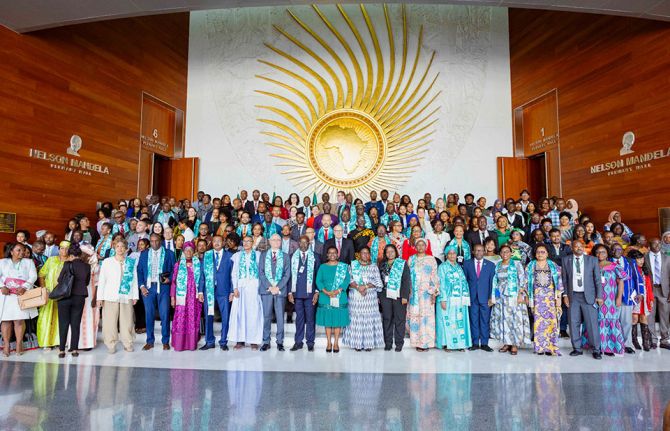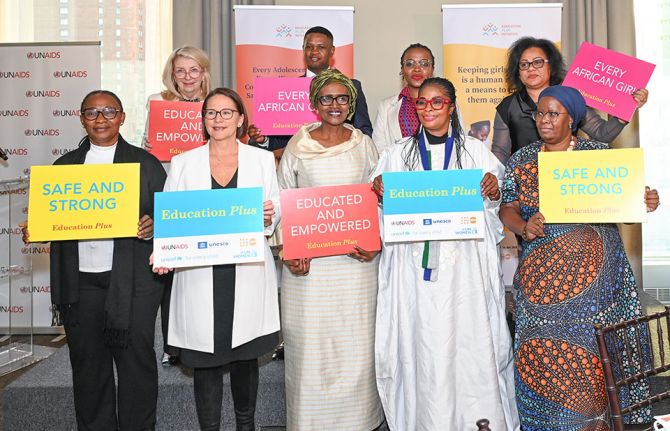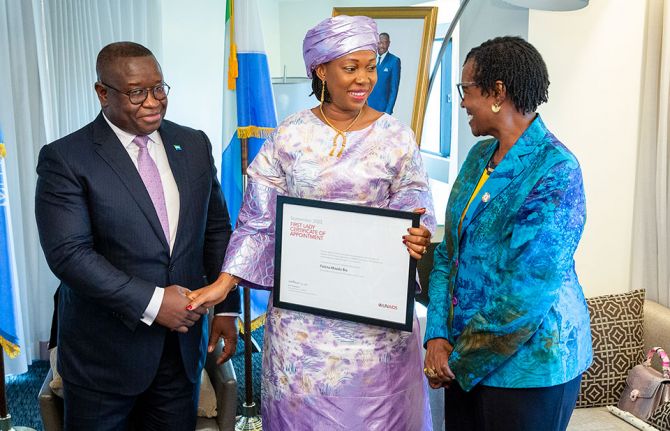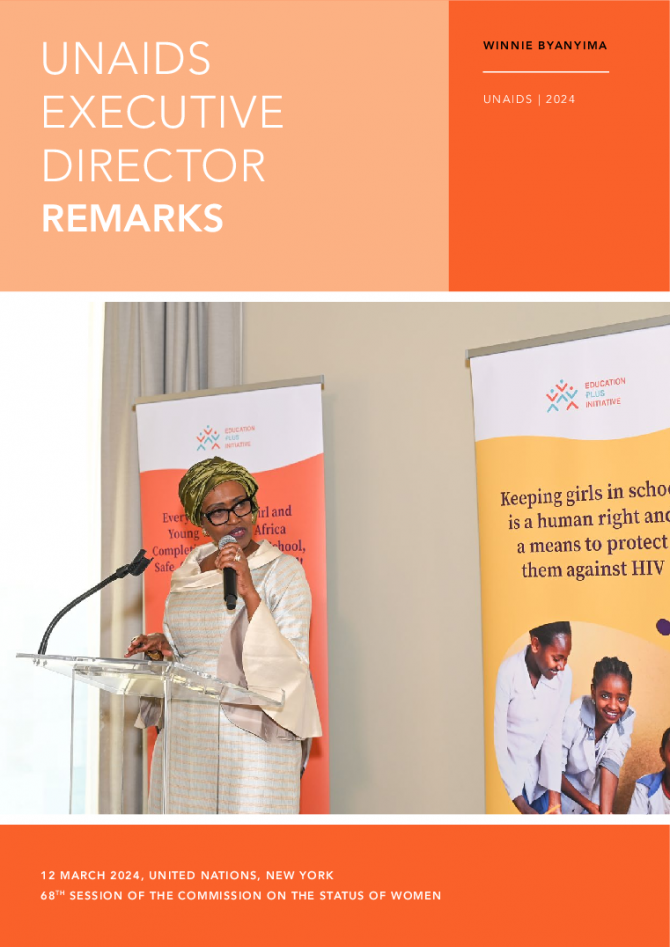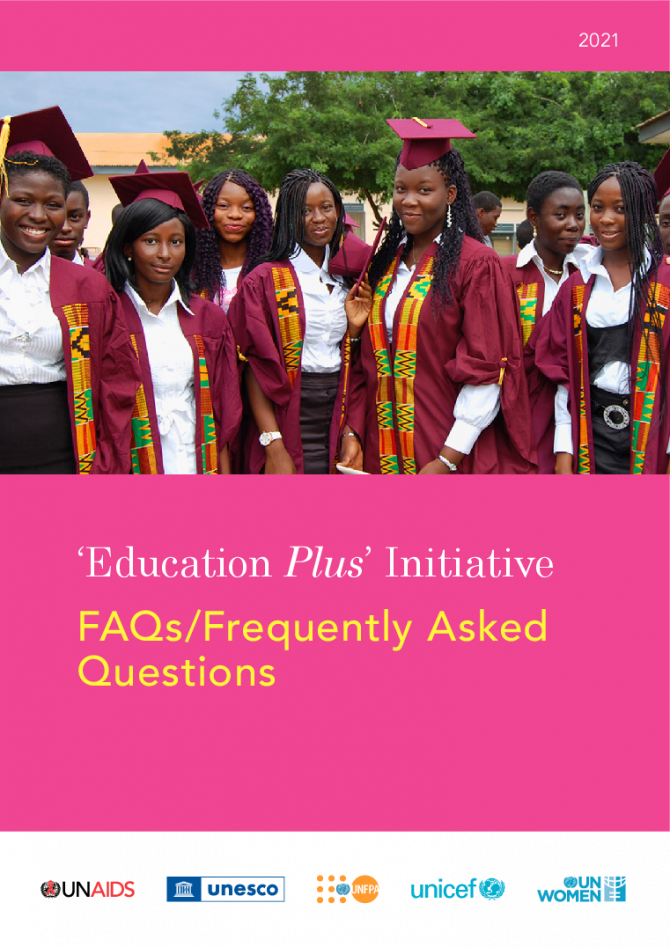
The ‘Education Plus’ Initiative (2021-2025) - Empowerment of Adolescent Girls and Young Women in sub-Saharan Africa
A joint initiative of UNAIDS, UNESCO, UNFPA, UNICEF, UN Women
The ‘Education Plus’ initiative is a high-profile, high-level political advocacy drive to accelerate actions and investments to prevent HIV. It is centred on the empowerment of adolescent girls and young women and the achievement of gender equality in sub-Saharan Africa—with secondary education as the strategic entry point.
- It responds to the urgency of effectively addressing the alarming numbers of adolescent girls and young women acquiring HIV and dying from AIDS, among other threats to their survival, well-being, human rights and fundamental freedoms.
- It challenges government decision-makers at the highest levels to model leadership and fulfill their essential duties to realize every girl’s rights to health and education. It brings added pressure to persuade governments to roll out universal secondary education, free for girls and boys. Completion of secondary education, an urgent concern in the COVID-19 context, also protects against HIV—with drops in new HIV cases among adolescent girls and young women by as much as one-third to one half in some countries.
- Evidence confirms that girls—and their communities and countries—reap multiple social and economic benefits from their completion of secondary school: reduced vulnerability to acquiring HIV and to becoming child brides and teenage mothers, while increasing their prospects for securing jobs and higher incomes as adult women, among others.
- The initiative is a rights-based, gender-responsive action agenda to ensure adolescent girls and young women have equal opportunities to access quality secondary education, alongside key education and health services and supports for their economic autonomy and empowerment. It will foster an enabling environment for adolescent girls and young women to enjoy safe and fruitful learning experiences, and to thrive while paving their way to vibrant futures. The rewards will also reach far into the longer-term, with inter-generational effects: Empowered girls are the empowered women of the future.
The initiative’s game-changing proposition is simple but ambitious--and long overdue.
- Challenge decision-makers and donors to significantly scale-up investments, policies and actions on education and holistic, multi-sectoral interventions for adolescent girls and young women to prevent HIV and gain many other social and economic benefits, including for those already living with HIV.
- Transform the promise of gender equality into a reality, in the context of the Beijing +25 process; as well as the Africa Agenda 2063, the Maputo Protocol on African Women’s Rights and the African Union Youth Charter, among other regional agreements on women’s and young people’s rights.
The initiative is spearheaded by five United Nations women leaders and the Joint United Nations Programme on HIV/AIDS.
- First announced by the UNAIDS Executive Director at the Nairobi Summit in November 2019 as her signature initiative upon taking office, the ‘Education Plus’ Initiative is endorsed and co-led by the heads of UNAIDS, UNESCO, UNICEF, UNFPA and UN Women.
- It harnesses the unique comparative advantages and capacities of the Joint United Nations Programme on HIV/AIDS, a partnership of 11 collaborating UN co-sponsors and the UNAIDS Secretariat, to bring on board governments, leading funding mechanisms, women’s, youth and diverse civil society networks and communities around this shared goal.
The 2016 Political Declaration on Ending AIDS aimed to reduce the number of new cases of HIV globally among adolescent girls and young women (15 to 24 years old) each year to below 100,000 by 2020. In 2019, this figure stood at 280,0003 worldwide---nearly three times the target.
In sub-Saharan Africa, adolescent girls and young women (15-24 years old) represented a quarter (24%) of all new cases of HIV in 2019—equivalent to 4,500 of them acquiring HIV every week. They also represented 72% of all new cases of HIV among this population group in the world, and 14% of all people in the world who acquired HIV. In 2019 in sub-Saharan Africa, 23,000 adolescent girls and young women died from AIDS-related illnesses.
The gender disparities are stark: within the region, adolescent girls and young women are more than twice as likely to acquire HIV than their male peers. Five in six new cases of HIV among adolescents between the ages of 15 and 19 are among girls. The high risk of acquiring HIV is just one of the many threats adolescent girls and young women face to their health, safety, dignity and life aspirations. While women and girls are biologically more susceptible to HIV than men and boys, unequal gender power dynamics and harmful gender norms are the root cause, compounded by intersecting forms of discrimination.
Keeping girls in secondary school is crucial—a right in and of itself, and a means to protect girls against HIV. Alarmingly, nearly 34 million girls, equivalent to 38% of girls between the ages of 12-14 and 60.5% of girls 15 to 17 years old, were not in secondary school and gender gaps in education persist, according to a 2018 analysis. Sub-Saharan Africa has the highest rates of child marriage and teenage childbearing in the world, factors that contribute to keeping them out of school. Adolescent girls and young women face multiple forms of gender-based and sexual violence, including in schools and from intimate partners. And 24% of young women 15-24 years old are not in employment, education or training. For young women who work, the conditions, pay and income security their jobs offer are poor.
These are among the structural inequalities that have only been exacerbated during the COVID-19 pandemic, and that threaten to roll back gains on their rights and gender equality. Meanwhile, all these intertwined issues in young women’s lives, such as HIV, early and unwanted pregnancy, and violence—and the gender dimensions that fuel them—are avoidable.
The 25th anniversary of the Beijing Platform for Action provides an opportune moment to demand accelerated action in response to the HIV crisis among adolescent girls and young women in sub-Saharan Africa. The Generation Equality Forum and the Action Coalitions serve as key platforms to call upon governments for game-changing commitments in line with this initiative’s vision.
The costs of inaction on realizing the human rights of adolescent girls and young women are significant. The achievement of the Sustainable Development Goals hangs in the balance unless the scale and quality of investments in adolescent girls’ and young women’s empowerment and gender equality are radically intensified. The costs are not only counted in terms of the harmful impacts on girls’ lives, but in how they undermine prospects for poverty eradication and the well-being and resilience of families, communities, societies and national economies.
For example, the costs of high adolescent childbearing range from 1-30% of annual GDP across African and other low- and middle-income countries, measured as young mothers’ forgone income during their life course. The lack of educational and economic opportunities that result in women’s diminished labour force participation is estimated to cost the Africa region US$60 billion in economic losses every year. On the other hand, Africa could gain US$500 billion per year through multi-sectoral investments in adolescents and youth, especially girls, by capitalizing on demographic windows of opportunity. The returns on smart investments, such as from getting all girls through at least secondary school and protecting their sexual and reproductive health and rights, yield multiple benefits for gender equality and social and economic development more broadly.
The key components of the `Education Plus’ approach include the essential elements of what every adolescent girl and young woman should be entitled to in transitioning to adulthood:
- Completion of quality secondary education
- Universal access to comprehensive sexuality education
- Fulfillment of sexual and reproductive health and rights
- Freedom from gender-based and sexual violence
- School-to-work transitions, and economic security and empowerment
Fostering an enabling policy and legal environment that protects the rights of adolescent girls and young women will be integral to advocacy for the package above. Particular emphasis will be placed on the leadership and engagement of adolescent girls and young women living with HIV–not only to benefit from the initiative’s impact, but also to bring their lived experiences to bear on the initiative’s development and implementation.
Key cross-cutting elements of this approach include advancing:
- Young women’s voices, leadership, participation in decision-making, and role as innovators
- Increased gender-responsive investments in evidence-based interventions that transform harmful gender norms and masculinities, engaging men and boys as advocacy allies and agents of change
- Quality learning to build broader life skills, critical thinking and entrepreneurial capacities
- Multi-sectoral, smart investments for impact and scale
The `Education Plus’ initiative is aimed at stepping-up investments in holistic, multi-sectoral approaches around these core elements of female empowerment and gender equality. It focuses on critical social enablers through a two-pronged strategy:
- Ensuring girls’ completion of quality secondary education through investments for roll-out of free universal access, as well as by ending discriminatory policies, laws and practices that deny girls their right to education. The initiative will call on governments to: commit to public financing so that all girls and boys can enjoy a secondary education; address the specific reasons why adolescent girls, in all their diversity, drop out or are not in school in the first place; advance policy and legislative solutions for removing the underlying gender-related factors (‘structural drivers’); and remove gender biases and stereotypes from school curriculae and teaching practices.
- Leveraging educational systems as strategic entry points for advancing gender equality and the empowerment of all adolescent girls and young women in the region by 2025, focused on delivering the other ‘plus’ package components through schools, services in their vicinity and strengthened cross-sectoral linkages.
The rights-based ‘Education Plus’ approach promotes a range of measures, such as to: end stigmatization against girls in education and health services (e.g., based on HIV or pregnancy status, or being a violence survivor); tackle taboos about sexuality; change parental consent laws so adolescents can access HIV prevention, treatment and care services, and other sexual and reproductive health services; ban the expulsion of pregnant girls from schools; use sports and other venues for community sensitization on gender equality and the importance of girls’ education; provide safe spaces for girls; enable access to vocational skills training and support for entrepreneurship; expand digital technologies for rural girls; and ensure safety against gender-based violence and sexual harassment in and around schools and the broader community, and end impunity for perpetrators.
Basic needs and practical measures will also be addressed—food security, nutrition, water and sanitation, mental health and menstrual hygiene management (i.e., removal of taxes on sanitary products)—alongside promotion of social protection measures, such as cash transfers and others that tackle poverty and gender-related factors that keep girls out of school and otherwise expose them to risks to their well-being and security.
The initiative’s vast coalition of high-powered institutions and influential partners will bolster high-level political leadership and resolve to make smart investments in the ‘Education Plus’ approach.
The initiative will reignite commitment to girls’ education. It will work to shift the mindsets of decision-makers, from heads of state to ministers of finance, donors and other development cooperation partners, and the UN System itself. And it will help to optimize the gender-transformative potential and impact of their investments. The initiative will pool the comparative advantages and contributions of the UN System agencies involved and of their vast networks of partners from across movements, disciplines and sectors—joined up around one shared vision and ambitious objective for high-impact advocacy and mobilization.
The initiative will achieve its aims by:
- Leveraging the political access and assets of the initiative’s powerful coalition of influential UN leaders and strategically positioned partners, who will serve as advocacy champions with the highest-levels of government, including through bilateral quiet diplomacy.
- Making the investment case through high-impact advocacy and communications tailored to policy-makers and investors that showcase the multiple returns of increasing investments in education and multi-sectoral, holistic interventions at scale.
- Targeting key policy and legislative reforms to protect the fundamental rights of adolescents and youth across the initiative’s issues of focus, and speed-up removal of restrictive and gender-discriminatory provisions that undermine the impact of existing investments.
- Bringing high-level political leadership and support at all levels behind multi-sectoral and gender-transformative programmes, including to overcome institutional barriers and sectoral resistances, and to ensure coherence between stated policy objectives and implementation practice.
- Amplifying and building synergies with other leading global and regional initiatives, and intensifying momentum on recent calls for action, including in the context of the COVID-19 pandemic, as well as opportunities in the framework of the 25th anniversary of the Beijing Platform for Action.
- Securing wide-scale mobilization of coalitions and networks, including at the community level, involving women’s, youth and civil society organizations, networks of women and girls living with HIV, teacher and parent associations, cultural and faith leaders who share similar objectives from across the different movements and disciplines reflected in the initiative’s areas of focus—and bringing them around a common goal for impact by 2025.
- Establishing and facilitating a vibrant platform for the meaningful engagement of adolescent girls and young women in co-creating, implementing and monitoring the joint initiative, strengthening accountability, and ensuring the participation of community leaders.
The initiative will operationalise its strategy and programme of work by establishing six inter-related pillars, each with its own dedicated partners, plans and processes for roll-out:
- High-level Policy-Advocacy, to drive the investment case to the highest-levels of decision-making
- Strategic Partnerships and Outreach, to secure top-level influencers and enroll allies throughout the five-year initiative, to maximize the initiative’s impacts as well as its sustainability
- Young Women’s Leadership and Engagement, in co-creating the initiative at regional and national levels, as lead protagonists and activists, and in the initiative’s accountability framework
- Think Tanks Group, involving a small group of internationally-renowned research institutions expert in the fields of multi-sectorial programming for adolescent girls and young women, as well as in political-economy, to translate cutting-edge evidence into policy and practice
- Multi-media Communications, to drive the initiative’s political and investment message through national press conferences, op-eds, authoritative articles and social media, with emphasis on the mobilization and participation of young women and youth and diverse communities, from grassroots to global levels
- Data Hub for Advocacy and Communications, to provide and generate novel high-impact data projections and visuals for high-level decision-makers to effectively make the case on costs of inaction and returns on investments.
The `Education Plus’ initiative is an urgent call for investment and action, backed by evidence. The costs of inaction jeopardise the achievement of the SDGs. The current situation is unacceptable. But it can be changed with determined political leadership, innovative partnerships and smart investments.


